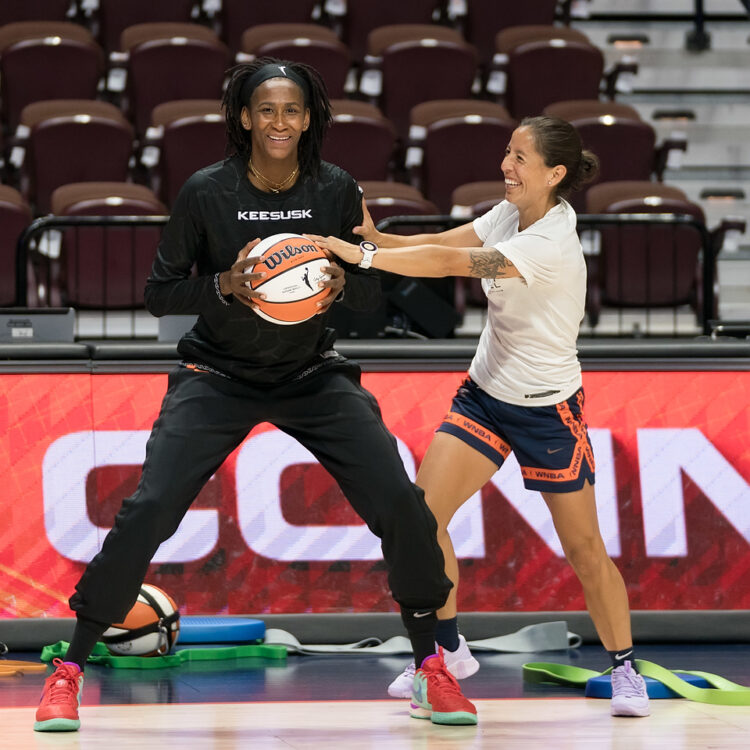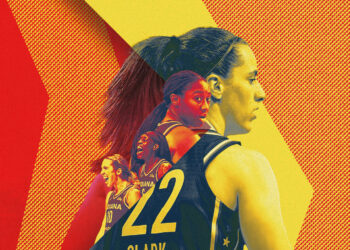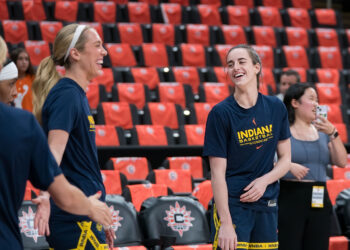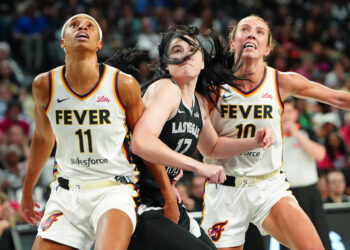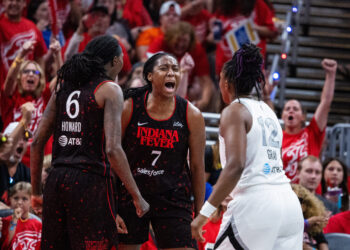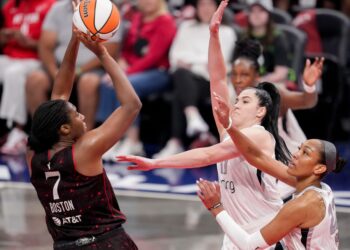Similarly, many athletic trainers and strength and conditioning coaches dedicate their lives to the sidelines, aspiring to reach a job in professional sports. With only 12 teams in the WNBA, opportunities for these jobs are extremely limited. The addition of the Golden State Valkyries in 2025 and the Toronto WNBA team in 2026 will open doors for new medical providers.
Several professionals’ career paths have involved a jump from the WNBA to the NBA, including:
- Jessica Cohen, a physical therapist and athletic trainer for the Milwaukee Bucks who was formerly with the Atlanta Dream and Chicago Sky
- Courtney Watson, the head athletic trainer for the Portland Trail Blazers, formerly with the Los Angeles Sparks and Houston Comets
- Michelle Anumba, assistant athletic trainer for the Utah Jazz, formerly with the Las Vegas Aces
But a closer look at the WNBA shows several providers who made the opposite decision, transitioning from men’s sports leagues into women’s sports.
Want even more women’s sports in your inbox?
Subscribe now to our sister publication The IX and receive our independent women’s sports newsletter six days a week. Learn more about your favorite athletes and teams around the world competing in soccer, tennis, basketball, golf, hockey and gymnastics from our incredible team of writers.
Readers of The Next now save 50% on their subscription to The IX.
Ciara Burgi, director of health and performance for the Aces, joined the WNBA after three seasons with the Houston Texans. She’s one of at least three WNBA medical staffers to leave the NFL for the WNBA.
“Working in the NFL for three years, I loved the guys. It’s the greatest group of men I’ve ever been around and worked with. But I think in a sport with a lot of history, history can be a barrier to innovation and creativity and change and momentum,” Burgi told The Next.
She continued, “There’s resistance to new ideas, and curiosity isn’t always welcome. Here, there is not a lot of history. There’s suddenly resources coming to the WNBA. There’s a lot of opportunity for creativity, for innovation, for bringing new systems, for bringing great minds together that are young and creative, and for building something that looks like nothing else. And so I think that is the draw for me. …
“Women’s sport doesn’t have elite care in the United States right now, and there’s no reason for them to not have elite practitioners around them, creating a professional environment and professionalizing women’s sport.”
WNBA medical staffs expand
Burgi is one of many WNBA newcomers joining the athletic trainers and strength coaches who work hard to keep players on the court or return them from injury as soon as safely possible. Their work involves countless hours in training rooms and weight rooms, in addition to the sidelines.
It’s no coincidence that the medical groups are expanding at the same time that the WNBA has experienced massive growth. The arrival of star rookies like Angel Reese and Caitlin Clark, both likely accustomed to this level of treatment with their college teams, has facilitated growth.
Three-time WNBA champion Alysha Clark spoke with The Next about the training staffs she has worked with in her 12-year career.
“I think it’s consistency, attention to detail and trying to stay ahead of the curve,” Clark said. “Everywhere I’ve played [Las Vegas, Washington and Seattle], I’ve been fortunate enough to have a training staff that approaches rehab and treatment that way. And so it’s no different here [in Las Vegas]. We have a great staff that are dedicated to making sure we’re our best version of ourselves out there on the floor, that provide whatever resources we need to make sure we’re healthy, and I’m grateful to be in this situation in this organization.”
Most teams have expanded their medical staff in an effort to reduce time missed due to injuries. Medical providers who have been around the longest, though, remember when one person had to wear many hats. While some of them prefer to remain out of the limelight, others expressed gratitude for the chance to share their work.
Starting from the beginning: Chicago’s Ann Crosby
Ann Crosby was hired as the Chicago Sky’s athletic trainer for their inaugural season in 2006. But she wasn’t available right away because she also worked as the head strength and conditioning coach at the University of Illinois Chicago (UIC).
“I came on probably the last maybe eight to 10 games; I can’t remember exactly when. So I didn’t technically start the season with them, although they were trying to get me,” Crosby told The Next.
That first season, she split her time between the Sky and UIC. Soon after, Crosby was expecting her first child. She explained to the Sky’s then-president and CEO, Margaret Stender, that she would be leaving. Navigating both jobs and parenthood wasn’t an option.
But Stender wouldn’t let her go. “She was really very, very, very sweet to me with everything, including helping me travel with a brand-new baby,” Crosby said. “Margaret made it amazing, and I decided to listen to them and gave them the parameters I needed to stay [with the Sky] and leave UIC.”
A fixture on the Sky sidelines since that first year, Crosby can be spotted in the second row behind the coaching staff during games. Eventually, she was promoted to her current role: vice president of operations and strength and conditioning coach. Her responsibilities include everything that doesn’t include an X or an O.
“I oversee all the medical stuff, including our team doctors … equipment, all the other operations aspects setting up practice,” she said. “All the stuff between the league and the players is under my umbrella as well. A little bit of everything.”
Crosby has been a steady presence for the Sky, helping them develop from inception to WNBA champions in 2021.

Veteran leadership: Minnesota Lynx’s Chuck Barta
Another familiar face on the WNBA sidelines, now in his 18th season, is Minnesota Lynx director of player performance and head athletic trainer Chuck Barta. Barta started in the WNBA after a long tenure in the NFL with the Minnesota Vikings.
He told The Next, “I thought my NFL career was long, and then I turn around and now my WNBA career has been just as long. I’ve been very lucky in the aspect of working with Coach [Cheryl] Reeve for such a long period of time. Head coaches don’t stay in the same spot for a long time … but I think Coach Reeve and I are in our 15th season together.”
Barta has been the Lynx’s athletic trainer for all four of their WNBA championships. When he started with the Lynx, the medical group was more of a one-man show, mostly limited by budgetary restraints.
“Those early years, the budget was so low, you were doing 25 jobs to make sure things were being done the way they should be done,” he said. “… It’s fun watching this thing grow exponentially the last few years.”

Over time, he’s had the chance to build a team of medical providers. “I want people going for gold. I don’t want to settle for silver,” Barta said. “The financial budgets weren’t there, but that does not mean in any sort that we could not have the same passion and engagement. I needed the right people for that. And our staff right now, I’m so excited. We’ve had [assistant athletic trainer] Brandi [BlueArm], and we just picked up [sports performance coach] Andrea [Hayden]. It’s fantastic. We’re growing.”
Barta and BlueArm are in their fourth season together, with Hayden added to the group this year.
Hayden’s road to the WNBA was “untraditional,” she said. She started working as a personal trainer in St. Louis right out of high school, ultimately going to college for her bachelor’s degree at age 24. During college, she started training the track and field and softball teams while building a network.
Those connections helped her land internships and opportunities. She went to China with the USA women’s ice hockey team, worked two seasons with the Minnesota Twins, and spent three seasons with Stanford women’s basketball and golf before landing with the Lynx.
“Along the way, it’s been the people that have opened up doors and opportunities,” Hayden told The Next. “I didn’t have much baseball experience, so I didn’t have any reason to be there except that someone took a chance on me. And then when I showed up, I worked really hard and made sure I earned that opportunity.
“Same thing at Stanford. I didn’t have much high-level basketball experience, but [head coach] Tara [VanDerveer] took the risk and brought me on.
“And [the] same thing now. The Lynx, I’m their first strength coach. They never had this position before. Thankfully, I met Chuck along the way, so when that opportunity happened, I was fortunate to be on his mind and to be chosen for this role.”
Want even more women’s sports in your inbox?
Subscribe now to our sister publication The IX and receive our independent women’s sports newsletter six days a week. Learn more about your favorite athletes and teams around the world competing in soccer, tennis, basketball, golf, hockey and gymnastics from our incredible team of writers.
Readers of The Next now save 50% on their subscription to The IX.
Barta, with nearly four decades of experience in sports medicine, shares his wisdom with his staff like a wise owl. “He’s just an awesome mentor to have because he’s had so many experiences,” BlueArm told The Next, “not just in the WNBA, but also with the Vikings. … I learn a lot from him every single day.”
Something the Lynx have focused on in recent seasons is treating postpartum athletes. “Coming back from pregnancy is really interesting for us,” BlueArm explained. “We’ve had Napheesa Collier come back after giving birth, and another player in the past, and we’re seeing that across the league. … We’re creating the standard for female athletes because the general population is not trying to get back to the same level of activity.”

Indiana Fever’s Todd Champlin on mental health care
Indiana Fever director of medical services and head athletic trainer Todd Champlin holds the third-longest WNBA sideline tenure with 10 years in Indiana and one season with the Seattle Storm. Champlin, who worked in minor league ice hockey for 15 years prior to the WNBA, grew up on skates in Buffalo, New York.
He described the evolution in licensure practices having pursued physical therapy prior to athletic training. “Back in the day, the horse-and-buggy days, physical therapy was a four-year bachelor’s degree,” Champlin told The Next. “And then I went to the University of Pittsburgh, [which] had advanced degrees for [physical therapists] who were already PTs. So I took their sports specialty track, which was sort of like an athletic training program. I did the internship route to be able to sit for the athletic training boards.”
The rules for board certification to become an athletic trainer have changed since Champlin’s certification in 1995. Now, physical therapists are required to complete three-year doctorate degrees after college to be eligible for licensure.
Athletic training education is evolving, with most of the WNBA athletic trainers holding master’s degrees. Because a bachelor’s degree is available for athletic training, many complete that for college and later pursue physical therapy.
Champlin shed light on some of the changes he’s observed. “One of the big areas is being more aware of mental health needs,” he said. “We’ve always had a sports psych person, and we’re fortunate because ours is also licensed in mental healthcare as a counselor. He’s a clinical psychologist.
“So we’re able to use him for both needs — from a performance aspect and also if someone has an issue that they feel they would like to talk to somebody about and get counseling. We’re able to use that same person. I think the amount of hours they are with the team now is like night and day compared to pre-COVID. It’s used a lot more, which is a good thing.”
Barta shared similar sentiments. “I think trained professionals are extremely important to have for an outlet,” Barta said. “And my focus is making sure the athletes all have someone they can talk to. They may have their own people, which is fantastic, but we have somebody available to them that is qualified. They’re very good, work with athletes and understand all the stresses the athletes [go] through.”
Champlin also explained how the WNBA’s scheduling can be grueling. “The schedule has always been compressed to some degree, even when we played 32 games,” Champlin said. “But now that we’re up to 40, and in a year like this year with a month off [for the Olympics], I think understanding the need for rest and days off, we’re probably giving the players more time off than what they had in the past.
“We’re appreciating that practices may not go as long or as hard, and understanding the importance of load management, whereas before there was such a grind.”
That grind for over a decade of WNBA work included a 2012 championship ring for Champlin.

Sideline crews are a team of their own
The Atlanta Dream’s medical staff has learned and grown together. Their director of medical services and head athletic trainer, Natalie Trotter, is in her fifth season and has worked alongside Katie Buria, Atlanta’s head of performance and rehabilitation, for three of those years. Prior to teaming up in Atlanta, Buria was a student of Trotter’s at Arkansas.
Trotter started in 2020, the WNBA’s COVID-19 bubble season, when staffs were kept at the bare minimum. After the next season in Atlanta, the Dream approved a full-time strength coach position. “That’s when Katie came on full-time,” Trotter said. “It’s huge in our growth and where we’re trying to take this thing. It’s great to have that consistent piece year after year instead of having to start over.”
Prior to joining the staff full-time in 2021, Buria interned with the Dream in 2019. She told The Next, “My first season here was [head coach] Tanisha Wright and [general manager] Dan Padover’s first season as well. So for me, seeing the growth of the Atlanta Dream over the past three years compared to where it was when I was an intern is a huge step in the right direction. … Last year, Year 2 with the staff, making it to the playoffs was a huge accomplishment.”
As team staffs grow, there’s more brainpower available to study how players are performing.
“In general, the W is becoming more aware of technology to be used and growing on the performance side,” Buria pointed out. “Using different devices to help better prepare our athletes, track how they’re doing throughout the season, what they look like coming in, midseason and postseason. So just being able to advance and enhance our players’ overall performance and well-being through technology sources has been a huge step over the last three years.”
Order ‘Rare Gems’ and save 30%
Howard Megdal, founder and editor of The Next and The IX, released his next book on May 7, 2024. This deeply reported story follows four connected generations of women’s basketball pioneers, from Elvera “Peps” Neuman to Cheryl Reeve and from Lindsay Whalen to Sylvia Fowles and Paige Bueckers.
If you enjoy his coverage of women’s basketball every Wednesday at The IX, you will love “Rare Gems: How Four Generations of Women Paved the Way for the WNBA.” Click the link below to order and enter MEGDAL30 at checkout.
The new technology
Buria continued, “In terms of wearables and force plates, this is our second season using both of them. We use them for practices and return-to-play purposes at this point, as the league doesn’t allow us to use them in-game. We get some in-game data from Second Spectrum, the video systems throughout the arena, so we get a glimpse of what in-game data might look like. Force plates we use a couple times a week. On game days, we look at preparedness and fatigue and readiness to play for our athletes.”
“I’m the technology whiz of this duo,” Trotter added. “I’m 100% kidding. Most of the technology is Katie; I just read the reports. … This is part of moving the needle. A lot has transpired over the last 12 months with it to provide our athletes what they deserve from prevention and recovery aspects.”
Dream player Nia Coffey told The Next how the medical staff has impacted her: “Oh my gosh, we could be here all day. Long story short, I didn’t really touch a weight until like two to three years ago when I had my knee injury, and I’ve been with Nat and Katie ever since. They’ve gotten me right. I feel like they’ve extended my career. I’m in the gym. I’m in the training room with them. They do such an amazing job. They are so smart. They know exactly what we need, how to do it, the frequency, everything. They have the technology, the resources. They’re my favorite.”
Coffey continued with more detail about the Dream’s use of force plate technology: “My biggest thing was the way I was jumping. It wasn’t conducive for my overall knee health. So they helped me figure out what’s the best way to jump, how to land, how to use my mechanics and my body best so that I can sustain everything because what I was doing before was causing a lot of pain. So they taught me how to use my body better.”
The new technology brings opportunities to grow the game and improve research, but it requires more education. When teams have such a small staff and no official way to collaborate, it’s difficult to collect enough data and analyze it. In the NBA, the athletic trainers are members of the NBA Athletic Trainers Association (NBATA), and the strength coaches have the NBA Strength Coaches Association (NBSCA). The WNBA doesn’t yet have any groups, but many staffs recognize the value in sharing knowledge.
For now, group chats between staffs are used to share information. They started when traveling teams asked what equipment or supplies home staffs would make available.
In Atlanta, the Dream staff participate in a book club. Trotter posted their book on her Instagram. “We do a couple a year,” she wrote in an Instagram message. “Katie is the librarian.”

New technology brings more data
When asked how many seasons she’d been in the WNBA, Sparks head athletic trainer Karissa Scherer cheered, “Rookie contract!” She’s working with Chelsea Ortega, the Sparks’ medical director, physical therapist, and strength and conditioning coach, who previously spent a season with the Aces.
“In women’s sports, we’re still working to find the budget to fund the things we want and need to do,” Ortega told The Next. “In the past, our whole entire performance staff has been one or two people. That’s injury prevention, that’s rehab, that’s strength and conditioning. That’s all the pieces in the WNBA.
“And now we’re seeing the staffs grow a little bit, but I’m the physical therapist and the strength coach and it’s great in some senses because I can cross over rehab with our strength training. But two brains are better than one sometimes.”
The newer staff members are entering the WNBA along with the new technology. They’ll need time to learn how to use it, but it will forever be part of their WNBA experience. The veteran providers are used to working without it.
“It’s kinda cool because we’re basically creating all the data for WNBA players and for female athletes that doesn’t currently exist,” BlueArm shared. “It’s useful for returning from injury as well.”
The NWSL appears to be leading the way in research and technology related to women in sports. Wearable devices can track heart rate and respiratory rate, or they can calculate sleep and energy scores, which can be compared to menstrual cycles or injury occurrences.
“We don’t have all the research on how menstrual cycle is affecting different types of injury and we’re starting to see some of that come out, but we don’t know how applicable it is and in what ways,” Ortega said. “I would venture to say that if men had a menstrual cycle, we’d have a lot more research on how it affects things and a lot more money put into it.”
Ortega compared WNBA schedules to those of other sports to demonstrate why soccer data can’t be used for basketball players. “A lot of the research in force plates is based in soccer or sports where there’s one or two competitions a week. In the WNBA, you’re playing upwards of three games a week. …
“So you talk to other strength professionals in our realm and the research isn’t necessarily laid out perfectly for us to figure out the right time. We can’t always test on ‘match day minus one’ and ‘match day plus two’ because ‘match day plus two’ is ‘match day minus one.’ So in a lot of research, our load monitoring looks a little different. We’re working on building out the best way to do that for our team, and I think that our schedule proves challenging for that.”
Scherer supports the increase in data collection but is concerned with the ethics of how it will be used. She told The Next, “I think the more data we can get, the better. Sometimes where it gets a little dicey is deciding who’s going to get access to that data, and then who is interpreting it, and then how we use it moving forward. I think the sports medicine and performance professionals should be the only ones reviewing the data, and then we can give our interpretation to members of the staff. But it’s a plus or minus for the athlete, too.”
She added that sometimes the metrics don’t match how the player is feeling, and that can impact their mental state going into competition.

They’re supporting the Olympians
The Next invited all WNBA athletic trainers and strength and conditioning coaches to be interviewed for this article. Eight teams participated. The New York Liberty view their medical staff as a competitive edge, so their staff did not complete interviews. However, Liberty general manager Jonathan Kolb released this statement to The Next editor-in-chief Howard Megdal:
“We are incredibly proud of the investment our ownership group has made into the New York Liberty’s performance staff over the past three seasons. Their commitment has led to added headcount, recruiting top talent and providing world-class medical care and performance resources for our athletes. Since the 2022 season, our performance staff has developed into what we believe is the top department in the WNBA in this space, which continues to be a paramount priority.”
Perhaps the Liberty do have a secret weapon. Their head athletic trainer, Terri Acosta, is serving as USA women’s basketball’s head athletic trainer at the Olympics.
And she isn’t the only WNBA connection with Team USA. Nicole Alexander was the Connecticut Sun’s head athletic trainer from 2021 to 2023 and is working alongside Acosta. Aces lead rehabilitation specialist Jerrica Thomas, who was a Sun Belt Conference champion in the triple jump, is in Paris providing medical care for USA track and field athletes.

Many are athletes themselves
While several athletic trainers and strength coaches played high school basketball, they also particiapted in other activities. Chelsea Ortega, then Chelsea Wolfe, rowed crew for UCLA. Sarah Kessler, the performance coach for the Fever, won two national championships as a rower at Ohio State. Burgi was a contemporary dancer in high school and college but grew up on a farm in Wisconsin.
“I grew up on a farm, and that’s what I did mostly. I did not have a lot of time or bandwidth for sports because I had to work,” Burgi shared. She spent most of her time milking cows and completing manual labor.
And then there’s Analisse Rios, head strength and conditioning coach for the Connecticut Sun. Growing up in Bolivia, she earned a spot on the national team for soccer at age 16. She played soccer and ran track for Connecticut College. After a few years in teaching, she returned to Connecticut College to coach and train soccer players, a role that evolved until she was training multiple teams and eventually the Sun. (Connecticut College is just eight miles from Mohegan Sun Arena and hosted the Sun’s practices for a time.)
Now in her fifth season with the Sun, she’s vital to their performance on the court. “Initially I was part-time with the Sun, but this year I’m full-time, working with players in Connecticut both in and out of the season and rehabbing injuries for those in-market,” Rios told The Next.
As an athlete herself, she knows how to train and uses this with her players. But when there’s injury, that’s even more difficult. Rios shared that rehabbing Achilles injuries is one of the more difficult things to treat: “I’ve had to rehab two Achilles injuries, so that is freshest in my mind right now. It’s tough because there’s such limited movement and such tiny little gains in the rehab progress.”
Add Locked On Women’s Basketball to your daily routine
Here at The Next, in addition to the 24/7/365 written content our staff provides, we also host the daily Locked On Women’s Basketball podcast. Join us Monday through Saturday each week as we discuss all things WNBA, collegiate basketball, basketball history and much more. Listen wherever you find podcasts or watch on YouTube.
Rios didn’t mention Brionna Jones’ Achilles injury, but now that Jones has recovered, Rios shared some of her approach to rehabilitation:
“I like to find exercises where they don’t realize what they’re doing until after they’ve done it. For example, in an Achilles rehab process, if I do an overhead medball slam [where the player lifts a weighted medicine ball over their head and then throws it down to the ground], inadvertently because they’re an athlete, they’re going to get up on their toes, which is a calf raise. They’re focused on the ball and they do those calf raises without thinking about them.”
She’s able to train the player to move in a specific way so they can achieve their training goals while focusing on something else.

Advice for aspiring sideline superheroes
Working alongside Rios is Sun head athletic trainer and physical therapist Ryan Newton. Newton previously worked as an Indiana Pacers physical therapy intern in 2017 and as head athletic trainer for the Fever for two seasons. He has also worked in the NWSL and spent a season in the NFL with the New England Patriots.
Newton told The Next his advice for athletic trainers or physical therapists who aspire to work in professional sports is, “Don’t be too selective with opportunities. If one comes your way with an opportunity to receive mentorship, take it for what it’s worth and try to squeeze everything you can out of it. Don’t be too proud to handle some menial task. Observe in-depth strategies that medical staffs use to manage athletes. Be present and ask appropriate questions when you’re able to.”
Rios added, “Study and fall in love with the sport. Fall in love with movement. Love watching different players move and seeing how they move, slowing down video to see how the human body moves. …
“I think this is what makes me love this job so much because I get to work with the most elite players, the top players in the world, and finding those little tiny things they can improve on in terms of strength or power. Find the little things that can help make them better at something they’re already good at.”

They work with coaches, too
Emily Blurton, the director of sport performance for the Storm, works closely with Seattle’s coaching staff in addition to training the team. Blurton is in her eighth season with the Storm after a one-year stint with the Sparks. She is the second-longest tenured strength coach in the WNBA after Crosby and has won two WNBA championships.
When she returned to Seattle this year, there was a brand-new practice facility housing the Storm’s new technology and growing staff.
Storm head coach Noelle Quinn was a player in Seattle when Blurton first joined the team. Quinn knows what it’s like to train with Blurton and explained the impact Blurton has on the Storm.
“Emily is the best in the business. She works very hard. She’s an athlete herself and so she understands the body,” Quinn told The Next. “She understands the team aspect of it. She’s been with us for a long time and she’s a champion. So to know what the season brings on an athlete is important. And she does an excellent job of manning the weight room, ‘woman-ing’ the weight room. It’s the science behind it. It’s the education behind it, coming in and having all the amazing equipment that we do have in the weight room to really focus in on our athletes.
“And she has a great presence about her. Emily is important for the success of the team because to stay healthy isn’t one aspect. It is the weight room. It is the training room. It is the athletes taking care of their bodies. It is what we do on the court as a staff. And so she is a big part of what we do.”
Aces head coach Becky Hammon, who is also a former WNBA player, told The Next how her medical staff helps keep her players and herself healthy:
“We have a great medical staff. I think they have a great way with the players. They create trust with the players. The players come in and do the work, the rehab or the rest, or whatever the medical team has them doing. So it’s a collaborative effort between both the players and the medical staff.”
She added, “They do a really good job. I know that and I make them work on me, too. Keep Coach going.”
Why they do it
Wth teams spread across the country, most staffers live far from home and miss holidays, celebrations and special occasions due to training and traveling. Bolivia, where Rios grew up, is a 4,000-mile flight from Connecticut. Wisconsin, where Burgi worked on the farm, is more than 1,700 miles from Las Vegas. And Blurton is from outside Fairbanks, Alaska, more than 2,000 miles from Seattle.
Before joining the Storm, Blurton was working in a chiropractor’s office doing rehabilitation training. She told The Next, “One of the assistant coaches for the Storm walked in, and I remember thinking how cool it was that he got to work with them. Wouldn’t it be amazing if 10 years from now, when I actually developed into a good coach, if I have the opportunity to work with someone like the Seattle Storm?”
A month later, she saw him again, and the Storm had an opening. He connected her with then-head coach Jenny Boucek.
Blurton continued, “Jenny and I chatted for a good length of time about sports performance and injury prevention and biomechanics, and by the end of it I told her straight up, ‘I have no experience. I should not be in this position. I’ve never worked with a team, let alone a professional team, but I do have a quick learning curve, and I will work really hard. But I think you should consider hiring someone else.’”
But Boucek hired Blurton as an assistant strength coach. By her second season, she had taken over.
“It was really challenging because I didn’t really know how to handle a professional team,” Blurton said. “… So much of it is understanding and respecting them as professionals, recognizing that it’s relationships and how you navigate them. It’s not dictating to them. It’s engaging with them in the process and having a very collaborative and mutually respectful dialogue. And it’s about giving them ownership over their own bodies. …
“The whole point is to empower them so that they understand themselves and have that safety, especially because so many of them have to go overseas.”
One of Blurton’s favorite stories with the Storm is about when she realized “the players were getting it.” In 2018, Blurton was working with center Mercedes Russell on step-ups, and guard Jewell Loyd came over.
Blurton recalls, “Jewell comes over to me, and asks, ‘Hey, Em, what are you looking at?’ And I was like, ‘Well, you tell me.’ And then she proceeds to list off, ‘You’re looking at her knee alignment, making sure that that knee is not flexing into valgus.’”
Blurton continued, “That was the moment where I felt like I’m making a difference. Jewell gets it. She could coach it now for another athlete. And that was the most cool experience to me, seeing her now carrying that on to her teammates, like, that was so cool. That was by far the moment where it was like, Oh, wow, this is actually working.”

The Next, a 24/7/365 women’s basketball newsroom
The Next: A basketball newsroom brought to you by The IX. 24/7/365 women’s basketball coverage, written, edited and photographed by our young, diverse staff and dedicated to breaking news, analysis, historical deep dives and projections about the game we love.
The work is great, but it’s a grind
The common thread among the athletic trainers and strength coaches is that their jobs are incredibly rewarding but also very difficult.
Trotter shared the pros: “One of my favorite parts of the job is also one of the hardest parts of the job. It’s these beautiful humans that we get to work with each and every day and the relationships that we’re able to build with them. There’s a little bit of tears, there’s a lot of laughs, a lot of fun. We like to have fun in the athletic training room, but we still get work done. … It is pretty cool to still have such an intricate part of their lives. … I know that I do this and it’s basketball, but they’re more than just athletes to me.”
She’s open with the cons, too: “With the evolution of athletic training, there’s a lot of people who think they want this and don’t really understand what it takes. It’s hard. There’s a bunch of hours, a lot of stuff that’s never ever seen. I tell people all the time that the worst part of my day is practice. I enjoy the games, but that’s the least amount of time spent when you think about the countless hours and work. It’s a hard job.
“If you love it and have a passion for people and a servant’s heart, that will take you far. I have a passion for athletic training, I have a passion for female athletes, I have a passion for the human body, the injuries, the nagging stuff. It keeps me coming back. Somewhere deep down, I love it. You need to figure out a lot of stuff about yourself because it’s a grind. At the end of the day, it’s a lifestyle. There are so many sacrifices. As our coach says, ‘It’s we over me.’”
Barta expressed the same sentiment. “It’s not a job, it’s definitely not a job. It’s a lifestyle. It is not, you go home at seven o’clock or after the game and you’re done thinking about it. You think about it at night and when you wake up. You’re always thinking. In your mind, you always have somebody that’s had some type of injury, maybe a chronic injury, they’re just trying to play through it or could be something that’s acute. But there’s always something. I don’t feel it’s fair to the athlete if you’re not taking the time to do whatever we can to help them get back to where they want to be.”
Champlin brought some levity to the hard work talking about his favorite superheroes. “When I was growing up, we only had Batman and Superman,” he said. “In the ’60s and ’70s, I’m not sure if we had anyone else. I’d identify most with Alfred, the butler. Putting out fires, keeping everyone moving in different directions. That was Alfred’s role with Batman and Robin.”
WNBA teams are staffed with numerous superheroes — athletic trainers and strength coaches keeping the players healthy and restoring them from injury. They don’t wear capes, but they’ve got athletic tape and brilliant minds. The WNBA could not function without them.
The Next’s Jenn Hatfield, Bella Munson, Hunter Cruse and Rob Knox contributed reporting for this story.
